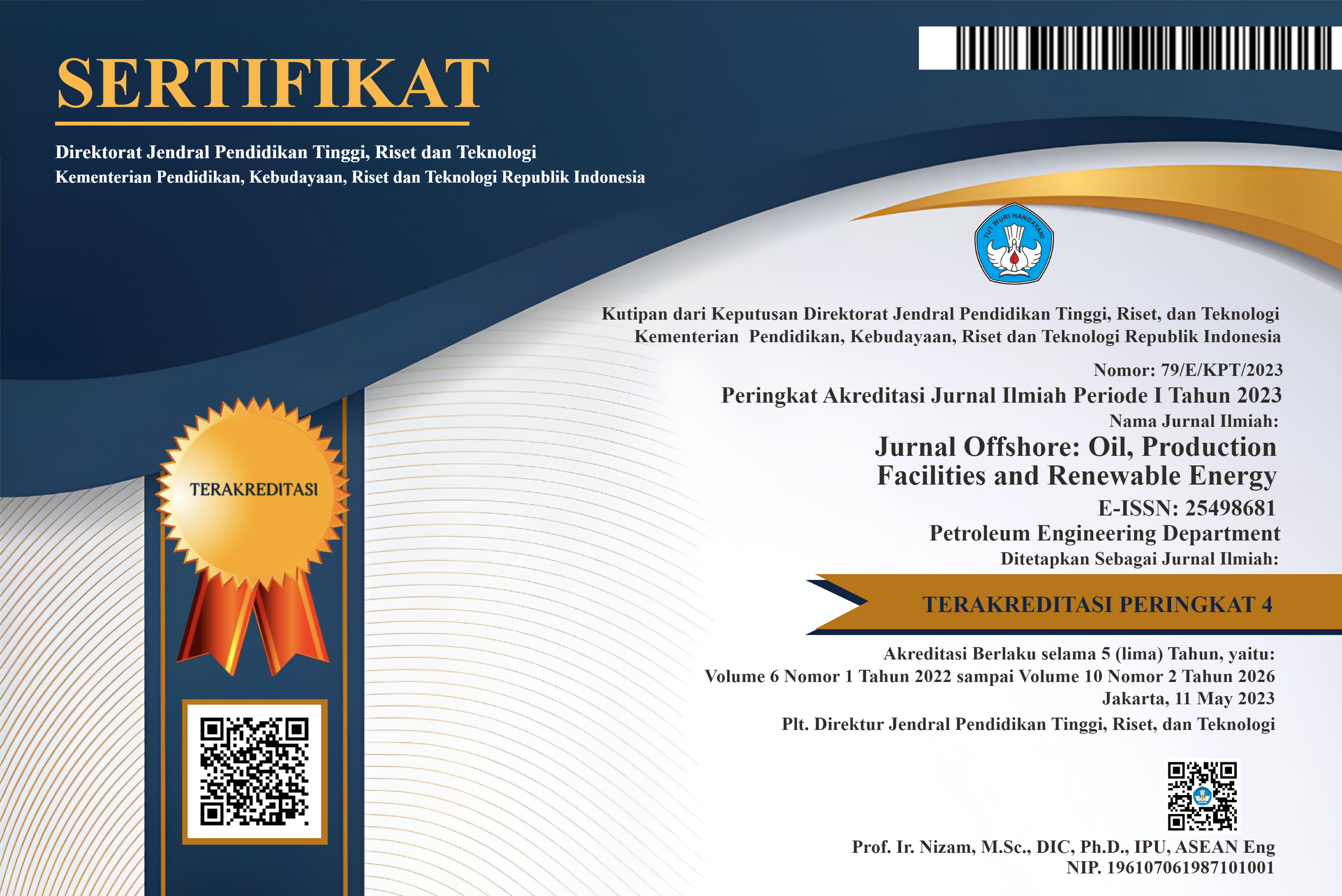Penentuan OOIP Berdasarkan Pemodelan Geologi dan Reservoir di Daerah Tanisha Cekungan Sumatra Selatan
DOI:
https://doi.org/10.30588/jo.v2i2.401Keywords:
pemodelan geologi, pemodelan reservoir, perhitungan cadangan, petrofisika, model statik, geological modeling, reservoir modeling, reservoir calculation, petrophysics, static modelAbstract
Perkembangan teknologi dapat dimanfaatkan untuk mengetahui karakteristik reservoir sebelum dilakukannya kegiatan eksplorasi dan eksploitasi. Salah satunya dengan pemodelan geologi dan pemodelan reservoir untuk mendapatkan gambaran bentuk bawah permukaan, karakteristik reservoir, dan OOIP. Analisis data log dan interpretasi geologi dilakukan untuk mendapatkan informasi lingkungan pengendapan, marker lapisan, dan bentukan struktur reservoir yang digunakan sebagai dasar pembuatan model geologi. Analisis petrofisik akan memberikan informasi mengenai karakteristik batuan reservoir. Untuk mendapatkan model reservoir, hasil analisis petrofisik akan didistribusikan pada model geologi. Kemudian penentuan OOIP dapat dihitung dengan menggunakan metode volumetrik. Reservoir batupasir sudah terbukti menjadi reservoir produktif di berbagai lapangan migas, seperti reservoir batupasir pada Formasi Talang Akar di Lapangan Sungai Lilin. Terdapat enam lapisan yang menjadi obyek penelitian pada Formasi Talang Akar yaitu lapisan D1, D2, E1, E2, F, dan H yang diendapkan pada lingkungan delta plain–delta front terlihat dari pola log yang berkembang yaitu funnel shape, serrated shape, dan bell shape. Perbedaan lingkungan pengendapan akan mempengaruhi geometri dan karakteristik reservoir. Didapatkan nilai cut-off untuk Vcl ≤0.40, porositas ≥0.10 dan saturasi air ≤0.7. Hasil analisis petrofisika kemudian didistribusikan pada model geologi dengan metode Sequential Gaussian Simulation , dimana penyebaran lingkungan pengendapan menjadi arahan dasar penyebaran properti reservoir. Perhitungan OOIP pada enam lapisan di Formasi Talang Akar berdasarkan pemodelan reservoir sebesar 8,387 MSTB, dengan lapisan menarik terdapat pada lapisan E2 2,340 MSTB.
Technological developments can be utilized to determine reservoir characteristics prior to exploration and exploitation activities. One of them is by geological modeling and reservoir modeling to get a picture of subsurface shapes, reservoir characteristics, and OOIP. Log data analysis and geological interpretation were carried out to obtain information on depositional environments, layer markers, and reservoir structure formations that were used as the basis for making geological models. Petrophysical analysis will provide information about reservoir rock characteristics. To get the reservoir model, the results of the petrophysical analysis will be distributed to the geological model. Then the determination of OOIP can be calculated using the volumetric method. Sandstone reservoirs have proven to be productive reservoirs in various oil and gas fields, such as sandstone reservoirs in the Talang Akar Formation in Sungai Lilin Field. There are six layers that are the object of research in the Talang Root Formation, namely layers D1, D2, E1, E2, F, and H which are deposited in the plain-delta front delta environment as seen from the developing log pattern, namely funnel shape, serrated shape, and bell shape. The difference in depositional environments will affect the geometry and characteristics of the reservoir. Obtained cut-off values for Vcl ≤0.40, porosity ≥0.10 and water saturation ≤0.7. The results of the petrophysical analysis are then distributed to the geological model using the Sequential Gaussian Simulation method, where the spread of the depositional environment is the basis for spreading reservoir properties. The OOIP calculation for the six layers in the Talang Akar Formation is based on reservoir modeling of 8,387 MSTB, with an interesting layer found at the E2 layer 2,340 MSTB.
References
Argakoesoemah, R.M.I., dan Kamal. A., 2004. Ancient Talang Akar Deepwater Sediments In South Sumatra Basin. A New Exploration Play, IPA 2006 – IPA-AAPG Deepwater and frontier Symposium 2004
Bohling, G. 2005. Introduction to Geostatistics and Variogram Analysis. Kansas, hal. 2.
Harsono, A, 1997. Evaluasi Formation dan Aplikasi Log, Schlumberger Oilfield Services, Jakarta, hal 1.
Honh, M.E, 1999. Geostatic and Petroleum Geology-Second Edition, Kluwer Academic Publisher, Inggris, hal 2
Kalan, T., Maxwell, R.J., dan Calvert, .J.H,1984. Ramba And Tanjung Laban Oil Discoveries Corridor Block, South Sumatra, IPA 2006-13th Annual Convention Proceeding
Partowidagdo, W, 2002. Manajemen dan Ekonomi Minyak dan Gas Bumi.
Purwanto, T., Isnaniawaghani, V., Mulyana, B., Widianto, E., 2015. Penentuan Posisi Marker Sekuen Stratigrafi Sebagai Dasar Pengikat Korelasi Lithostratigrfi Di Daerah Limau Cekungan Sumatra Selatan, Seminar Nasional Ke-II Fakultas Teknik Geologi Universitas Padjajaran
Schlumberger, 2010.Petrel 2010.1 Full Manual. Schlumberger.
Selley, R.C, 1998. Elements of Petroleum Geology, Second Edition. USA: Academic Press, hal 240.
Sembodo, H., dan Nugrahanti, A, 2012. Penilaian Formasi II, Universitas Trisakti, Jakarta, hal. 46.
Tamtomo, B., Yuswar, I., Widianto, E., 1997. Transgressive Talang Akar Sands Of The Kuang Area, South Sumatra Basin: Origin, Distribution And Implication For Exploration Play Concept, IPA-Proseedings of The Petroleum System of SE Asia and Australasia Conference.
Zakrevsky, K.E., 2011. Geological 3D modelling. European Association Geoscientist & Engineers Publication, Belanda
Downloads
Published
How to Cite
Issue
Section
License
Authors retain copyright and grant the Jurnal Offshore right of first publication with the work simultaneously licensed under a Creative Commons Attribution 4.0 International License that allows others to share (copy and redistribute the material in any medium or format) and adapt (remix, transform, and build upon the material) the work for any purpose, even commercially with an acknowledgement of the work's authorship and initial publication in Jurnal Offshore. Authors are able to enter into separate, additional contractual arrangements for the non-exclusive distribution of the journal's published version of the work (e.g., post it to an institutional repository or publish it in a book), with an acknowledgement of its initial publication in Jurnal Offshore. Authors are permitted and encouraged to post their work online (e.g., in institutional repositories or on their website) prior to and during the submission process, as it can lead to productive exchanges, as well as earlier and greater citation of published work (See The Effect of Open Access).
















